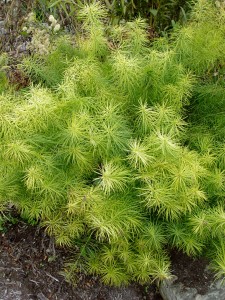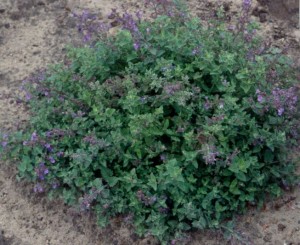Top 10 Perennial Flowers
June 23rd, 2015
So many good plants and so little space to plant them all…
Almost all of us are limited in what we can grow, so it helps to start with the best. That’s pretty subjective, but I have my short list of favorites.
For your plant-picking consideration, here are my picks of top 10 perennial flowers (at least as of this moment), followed next week by my top 10 flowering shrubs and then by my top 10 shade trees the week after that.
My top 10 annual flowers and top 10 small trees are already posted on my George’s Favorite Stuff page.
1.) Creeping sedum ‘Angelina’ (Sedum rupestre). I really like this little creeper as a colorful groundcover and alternative to mulch.
‘Angelina’ is a succulent that has golden foliage that looks like fat needles… very textural. It only grows 3 or 4 inches tall and spreads thoroughly but not aggressively.
The bright gold foliage turns burnt orange and stays that way all winter, making it an “evergreen perennial.” Then it golds back up again in spring.
It also gets yellow flowers in early summer that can be weed-whacked off after they fade. And it’s very heat- and drought-tough and not attractive to bugs or animals. Best in full sun.
2.) Coralbells ‘Caramel’ (Heuchera). You’ll find lots of great coralbells these days, but this one stands out from the crowd to me.
‘Caramel’ is a sturdy grower with nearly hand-sized leaves that change color throughout the year – mostly in shades of creamy gold and butterscotch. By mid-season, it’s almost 2 feet tall and slightly wider, so it really makes a statement in the garden.
This variety also gets a few white flower spikes in summer, but it’s the season-long colorful foliage that makes it such a winner. Best in morning sun and afternoon shade.
3.) Barrenwort (Epimedium). I’ve never seen a bad epimedium, but for some reason, this trouble-free perennial is little known and seldom used in home gardens.
The ones I like best grow about 1 foot tall, have heart-shaped leaves with burgundy tinges in spring and fall, and get hanging bell-shaped flowers of pink or yellow in April.
My favorite is epimedium ‘Rubrum’ (pink flowers), closely followed by the yellow-blooming ‘Frohnleiten’ and ‘Sulphureum.’ You might also see these nicknamed “bishop’s hat” or “fairy wings.”
They’re best in shade to part shade and also do well in the dry shade and root competition under trees.
4.) Threadleaf bluestar (Amsonia hubrichtii). This prairie native is another little-known perennial that most people like a lot once they see it in action.
Threadleaf bluestar looks more like a frilly bush with its 3-foot-tall stems of narrow, willow-like foliage that’s a green/chartreuse in summer and golden in fall. It’s both textural and colorful. The clusters of spring blue flowers are a bonus.
This plant seldom runs into any drawbacks and is fine both with our hot, dry summers and periodic wet spells. Best in full sun.
5.) Hardy geranium ‘Biokovo’ (Geranium cantabrigiense). I’ve been growing this bullet-proof perennial for 20 years and was happy to see it finally recognized by being named the Perennial Plant Association’s 2015 Perennial Plant of the Year.
‘Biokovo’ grows into a dense mat of broad green foliage, making it useful as a groundcover – even in poor soil and tree-root competition. It flowers pinkish-white for 3 to 4 weeks in late May to early June. The leaves turn burgundy in fall before dropping over winter.
This one is way more durable than the better-known Rozanne, which I’ve seen fizzle out in a few years. ‘Biokovo’ gets better with age and has no issues with bugs, disease or animals. Works in full sun or part shade.
6.) Dwarf purple coneflowers (Echinacea purpurea). I like most purple coneflowers for their big, showy, mid-summer flowers, but many of them flop from height. That’s why I lean toward compact varieties, such as Pixie Meadowbrite, ‘Little Giant,’ ‘Kim’s Knee High’ and PowWow ‘Wild Berry.’
Those stay under 2 feet tall but maintain the big flower size, vibrant pink to lavender color and long bloom time.
Coneflowers are very heat- and drought-tolerant, but they do need deadheading after flowering and are sometimes targets of groundhogs. Best in full sun.
7.) Meadow sage (Salvia). As with coneflowers, I lean toward the more compact versions of perennial salvias. Especially good are ‘Marcus,’ Sallyrosa ‘April Night,’ and the best known ‘May Night.’
These all get purple flower spikes in late April into May, often blooming for 6 weeks or more. Cut them back after bloom and they repeat in early fall, making salvia one of the longest blooming choices among all perennials.
I’ve never run into any bug, disease or animal troubles with any salvia. And they’re also among the best choices for heat, sun and drought.
8.) Dwarf catmint (Nepeta). This one would be used much more if it didn’t have “mint” in the name. Gardeners who have had bad experiences with the invasive nature of most mints shy away from anything with the “M” word in it.
Catmint isn’t a runner, though. It spreads in a gradually widening clump like most perennials do and offers the hard-to-find color of blue in its long-lasting flowers. Catmint blooms for nearly 2 months starting in late spring, then flowers again from early fall on if you cut it back to a stub after the first bloom finishes.
This is a great choice for your hottest, driest spot in the yard, including sunny banks and along hot asphalt driveways. It’s also highly attractive to bees, which is good or bad depending on your point of view (good in my view).
My favorites are compact types, such as ‘Kit Cat,’ ‘Blue Ice,’ ‘Little Titch’ and Junior Walker.
9.) Euphorbia polychroma ‘Bonfire.’ The changing, colorful foliage is what I like best about this 16-inch-tall perennial. The leaves start out green and soon turn to an attractive green-burgundy tinging that lasts all season.
‘Bonfire’ also flowers yellow in mid-spring, which is a perfect match for the dark foliage. But the best trait is the waxiness of the leaves, which causes raindrops to bead on the leaves. Run outside to see the plant glisten right after a rain.
I haven’t seen any bug, disease or animal issues with ‘Bonfire,’ but it does seem to fade away with time (i.e. a “short-lived” perennial). It’s worth the limited lifespan, though. Use in full sun to part shade.
10.) False forget-me-not ‘Silver Heart’ (Brunnera macrophylla). This one debuted in 2014 and right away impressed me as a more vigorous and durable alternative to the beautiful ‘Jack Frost’ brunnera, which tends to melt away in our heat and humidity.
‘Silver Heart’ has hand-sized silver leaves with green veins and lots of soft-blue forget-me-not-like flowers in mid-spring. It’s extremely showy for that season-long silvery foliage and is a plant that always draws people to ask, “What is THAT one?”
Grow in shade to part shade and think about pairing it with some blue-blooming hydrangeas.












